Next-Gen Advertising: The Best Online Display Ads to Boost Your Brand in 2024

It’s not a secret, that the digital marketing climate keeps shifting. This is the reason the role of online display ads in drawing attention, attracting clicks, and boosting sales hasn't waned. Entering 2024, it's essential to embrace the newest and most impactful ad formats out there. This guide will take you through the best online display ads to experiment with in 2024, arming you with strategies to elevate your advertising game.
Understanding the 2024 online display ad landscape
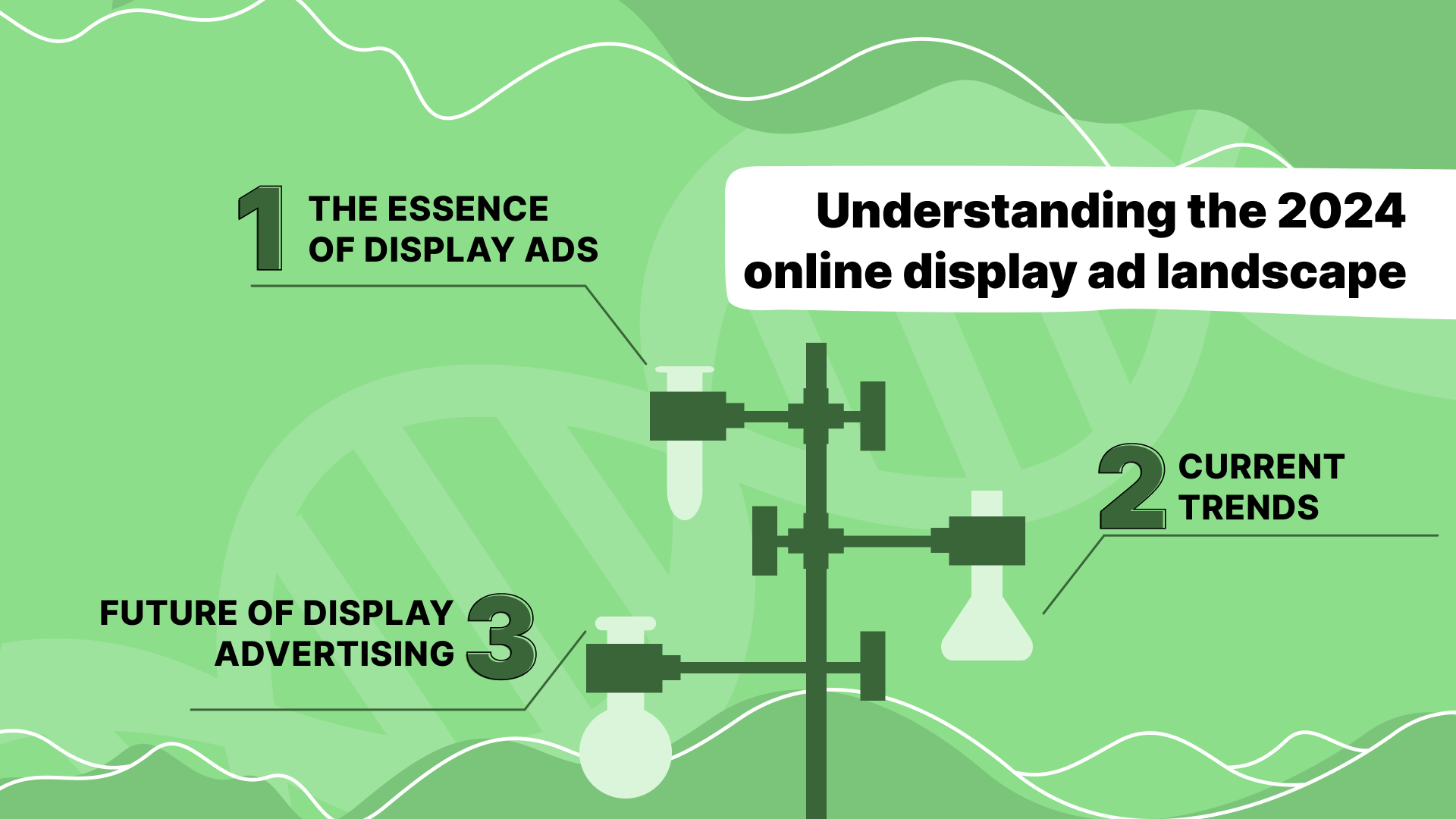
As we delve into the intricacies of display ads, let's explore their core essence, trace their evolution bolstered by technological advancements, examine the prevailing trends shaping the digital advertising landscape, and peek into the future to speculate on emerging formats and innovations.
The essence of display ads
At its heart, online display advertising is all about capturing the attention of your audience in the vast digital world. These ads, ranging from eye-catching banners to interactive multimedia, are designed not just to inform, but to enthrall and engage potential customers.
The journey of display advertising has been a remarkable one, evolving from simple banner ads in the early days of the Internet to today's sophisticated campaigns powered by AI and machine learning. These technologies have revolutionized how ads are targeted and personalized, making it possible to deliver content that resonates on a deeply personal level with viewers.
Current trends and future of display advertising
Nowadays, creativity and technology blend seamlessly, leading to trends that prioritize immersive experiences and respect for user privacy. Advertisers are increasingly leveraging formats that offer value and relevance, minimizing disruption to the user experience.
As we look ahead, the horizon is buzzing with the promise of new formats and technologies. Augmented reality (AR), virtual reality (VR), and even more advanced machine learning applications are set to personalize further and enhance the ad experience, making it more engaging than ever before. You can also utilize AI power for design purposes to make your display ads user-friendly and eye-catching. These advancements herald a future where display ads are not just seen or heard, but felt, offering unparalleled opportunities for brands to connect with their audience.
The best online display ads to try in 2024
The evolution of online display ads stands at the heart of this transformation, blending cutting-edge technology with creative storytelling to capture attention in the bustling digital ecosystem. From the immersive engagement of interstitial ads to the personalized appeal of dynamic content ads, and the subtle effectiveness of native advertising, let’s explore the forefront of advertising strategies that promise to elevate your brand's digital presence.
Interstitial advertising
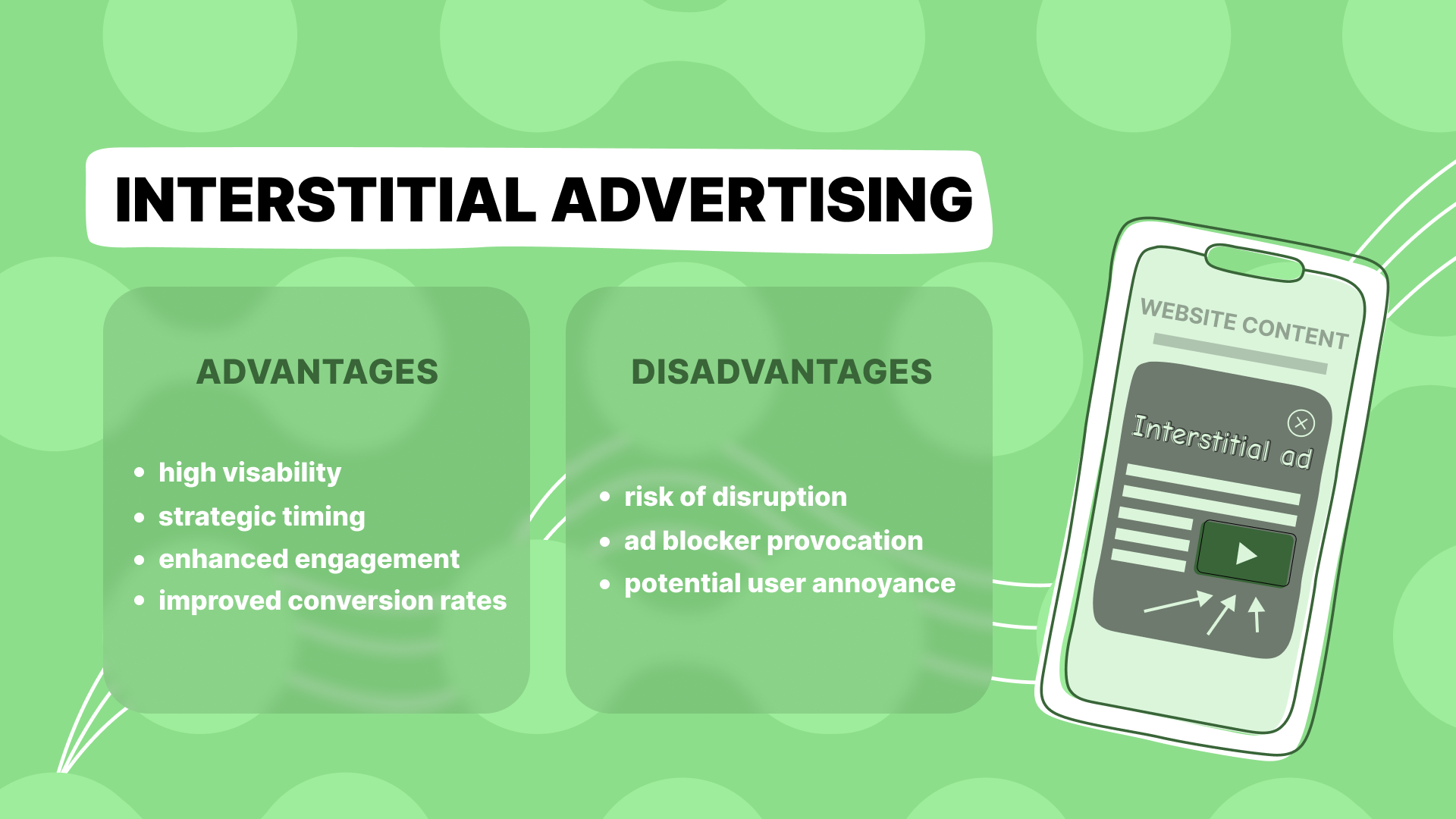
Interstitial ads, known for their full-screen format, strategically intercept the user's digital journey, creating a momentary pause to showcase compelling content. These ads excel in drawing complete viewer attention by covering the interface of an app or website during transitions, offering a distinct canvas for advertisers to deliver their message.
- The mechanism behind interstitial ads
Interstitial ads ingeniously weave into the user experience by surfacing at natural breakpoints, such as between game levels or before a new article loads. This timing ensures that users are less likely to feel interrupted since they're already expecting a pause. The ad's architecture allows for rich media incorporation, from video to interactive elements, enhancing engagement opportunities. To gain a deeper understanding of working with interstitial ads, learn our detailed guide. - The ideal audience for interstitial ads
This ad format is tailor-made for direct advertisers who demand high visibility and engagement for their campaigns. It's a favorite among mobile game developers, e-commerce giants, and entertainment platforms aiming to promote app installations, special offers, or content subscriptions. Its impactful presentation and timing make it a formidable tool for capturing user interest and driving action.
Advantages of interstitial ads
- High visibility: Dominates the screen, ensuring the message doesn't just get noticed but is absorbed.
- Enhanced engagement: The captivating format supports rich media, inviting users to interact.
- Strategic timing: Minimizes disruption by appearing at natural transition points in the user's journey.
- Improved conversion rates: With the user's full attention, these ads often see higher click-through and conversion rates.
Disadvantages of interstitial ads
- Potential user annoyance: If overly intrusive or frequent, they can frustrate users, risking engagement.
- Risk of disruption: Poor timing or relevance can interrupt the user experience, leading to negative perceptions.
- Ad blocker provocation: Their conspicuous nature might encourage the use of ad blockers among some segments of the audience.
Popunder ads
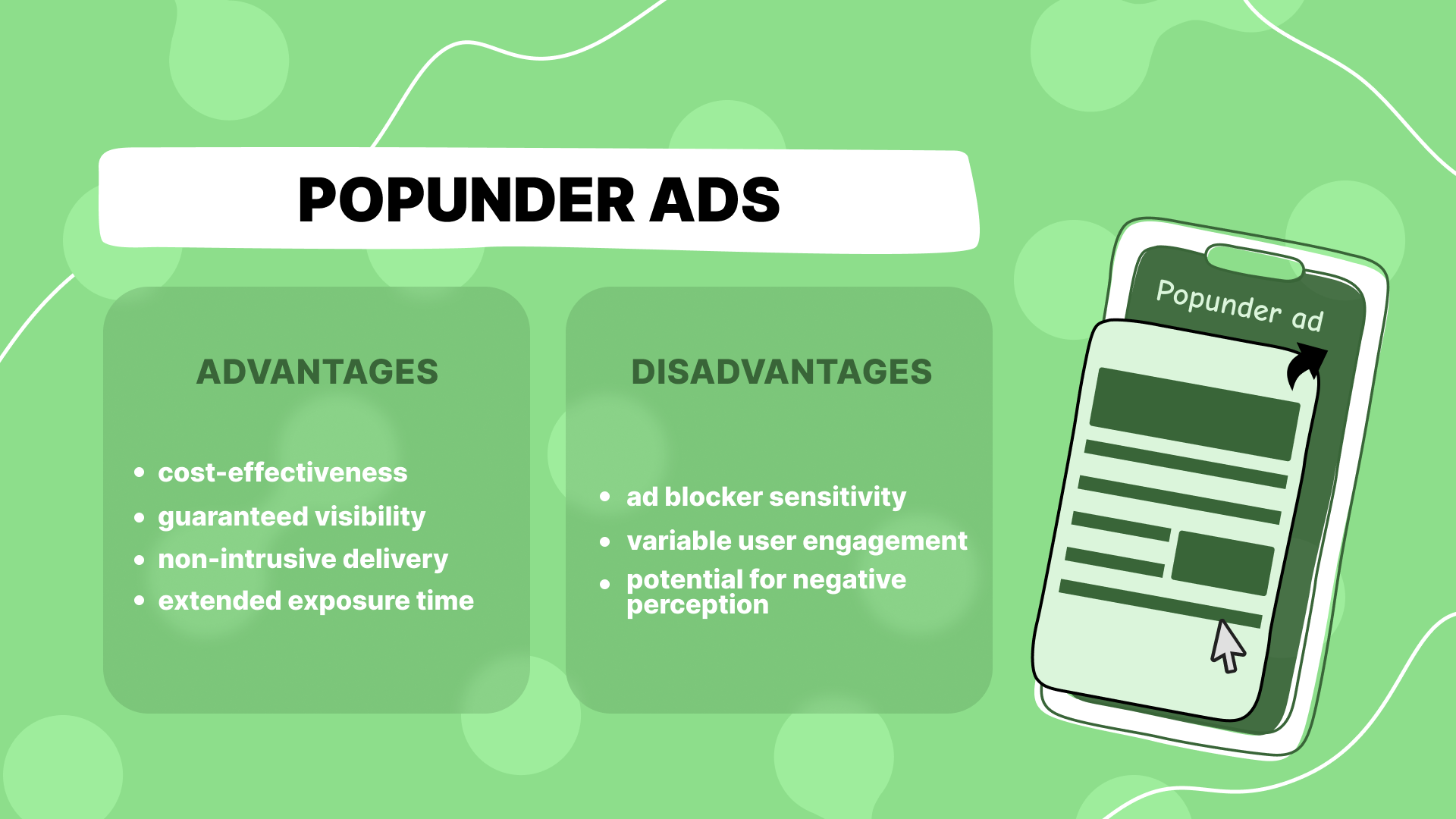
Popunder ads operate on a principle of subtle engagement, opening behind the active window or tab, thereby ensuring that the user's immediate experience remains uninterrupted. This type of ad is distinguished by its ability to remain unnoticed until the user closes or minimizes their current browser window, revealing the ad underneath. It's a strategy that banks on surprise and delayed discovery, offering advertisers a unique method to capture attention.
- Mechanism of action
The popunder ad quietly launches in a new browser window underneath the current content being viewed. This is typically triggered by a user's click on the webpage, ensuring the ad's presence is subtly integrated into the user's online activity. Only when the user finishes with the initial content and closes or minimizes their browser window do they encounter the ad, which now occupies their full attention. Generally, monetizing popunder traffic is a whole art and you better familiarize yourself with this helpful guide before you start. - The target audience for popunder ads
Popunder ads are particularly valuable for advertisers looking for a less intrusive way to ensure their campaigns are seen. This format is favored by direct advertisers in industries like online gaming, adult entertainment, and various digital services, who benefit from its ability to deliver sustained visibility without disrupting the user experience. It's ideal for campaigns aiming for high impressions with a more guaranteed viewability.
Advantages of popunder ads
- Non-intrusive delivery: Allows users to engage with content uninterrupted, with ads waiting quietly in the background.
- Guaranteed visibility: Ensures ads are seen when the user closes their main window, providing a captive audience moment.
- Extended exposure time: The ad remains open until actively closed by the user, increasing potential engagement time.
- Cost-effectiveness: Often more affordable than more intrusive ad formats, offering a good ROI for awareness campaigns.
Disadvantages of popunder ads
- Potential for negative perception: This can be seen as deceptive, leading to frustration once discovered by the user.
- Ad blocker sensitivity: High susceptibility to being blocked by ad blockers, reducing their reach and effectiveness.
- Variable user engagement: While visibility is high, the engagement level can vary widely, depending on the user's interest and perception of the ad's relevance and intrusiveness.
Banner advertising
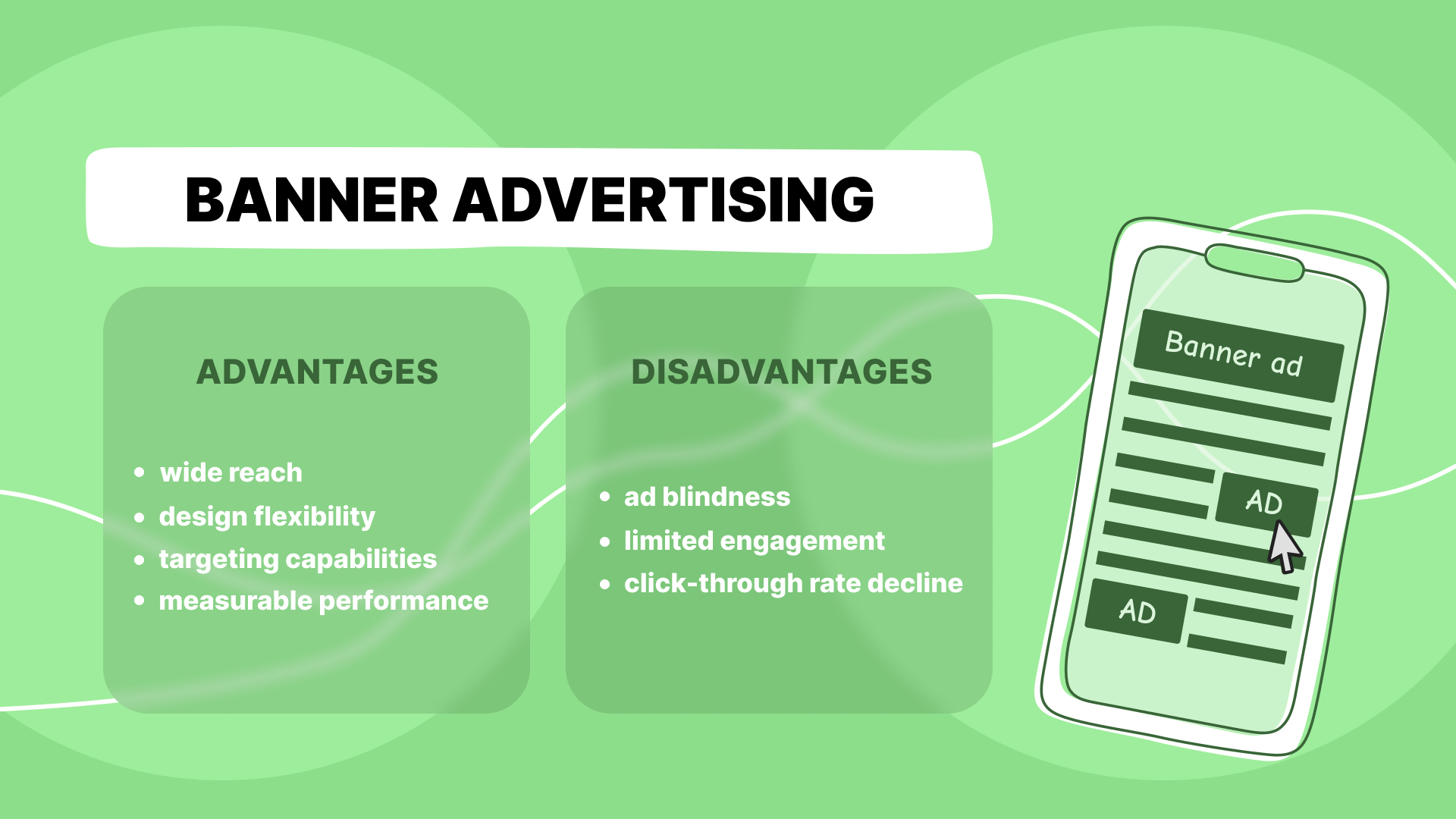
Banner ads are the quintessential form of online advertising, characterized by their rectangular or square format typically positioned at the top, bottom, or sides of a website. They blend visuals and text to catch the eye of the website visitor, aiming to convert passive viewing into active engagement. This ad type has the versatility to be both simple and complex, incorporating static images or animated graphics to communicate a brand's message.
- How banner ads function
Banner ads work by embedding a clickable image on a webpage, leading the viewer to the advertiser's chosen landing page when clicked. This direct route from ad to action facilitates a streamlined user journey, ideally converting interest into measurable outcomes, such as sales or leads. The success of a banner ad often hinges on its design, placement, and the relevance of its message to the website's audience. - Ideal for direct advertisers
Direct advertisers, especially those in e-commerce, technology, and service industries, find banner ads especially advantageous due to their straightforward approach and broad reach. These ads offer an effective platform for launching new products, promoting sales, or increasing brand awareness, thanks to their ability to target specific demographics and track performance metrics accurately.
Advantages of banner ads
- Wide reach: Capable of reaching a vast audience across numerous websites.
- Design flexibility: Allows for creative freedom in design, from static images to rich media.
- Measurable performance: Easy to track clicks, impressions, and conversion rates for ROI analysis.
- Targeting capabilities: Can be tailored to specific audiences based on demographics, interests, and behaviors.
Disadvantages of banner ads
- Ad blindness: Overfamiliarity can lead users to ignore banner ads, reducing their effectiveness.
- Limited engagement: The static nature of some banner ads may fail to engage users as dynamically as other ad types.
- Click-through rate decline: Generally lower click-through rates compared to more interactive or novel ad formats.
Push advertising

Push ads represent a proactive approach in the digital advertising space, where notifications are sent directly to a user's device or browser, even when they are not actively browsing. These ads leverage the personal and immediate nature of push notifications to deliver concise, impactful messages directly to the audience. Unique in their ability to reach users outside of the browsing context, push ads offer a direct line of communication that can significantly boost engagement.
- Operational dynamics of push ads
Push ads operate by sending notifications to users who have previously agreed to receive them, ensuring a level of pre-existing engagement and interest. When a user opts-in, advertisers can then push ads to their devices or browsers, which appear as alerts or pop-up messages. Clicking on these notifications will direct the user to more detailed content, such as a landing page or an app. To more professionally understand the nuances of working with push advertising, we advise you to read additional advanced material. - Who benefits from push ads?
Direct advertisers, particularly those in e-commerce, media, and event promotions, find push ads invaluable due to their immediacy and high engagement rates. This advertising format is highly effective for time-sensitive offers, breaking news, or reminders, making it ideal for campaigns that benefit from immediate user action.
Advantages of push ads
- Direct user engagement: Offers a direct line to users, enhancing the likelihood of immediate engagement.
- High visibility: Breaks through the digital noise by delivering messages straight to a user's device.
- Opt-in audience: Targets a self-selected audience, improving the relevance and reception of ads.
- Effective for time-sensitive campaigns: Ideal for promotions, alerts, or any content requiring swift attention.
To explore an extended list of the benefits behind push advertising, dive into this article.
Disadvantages of push ads
- Potential for annoyance: Overuse or irrelevant notifications can lead to user frustration and opt-out.
- Limited space for content: Requires messages to be extremely concise, which may limit the depth of communication.
- Privacy concerns: Users may have privacy concerns, affecting their willingness to opt in.
Native advertising
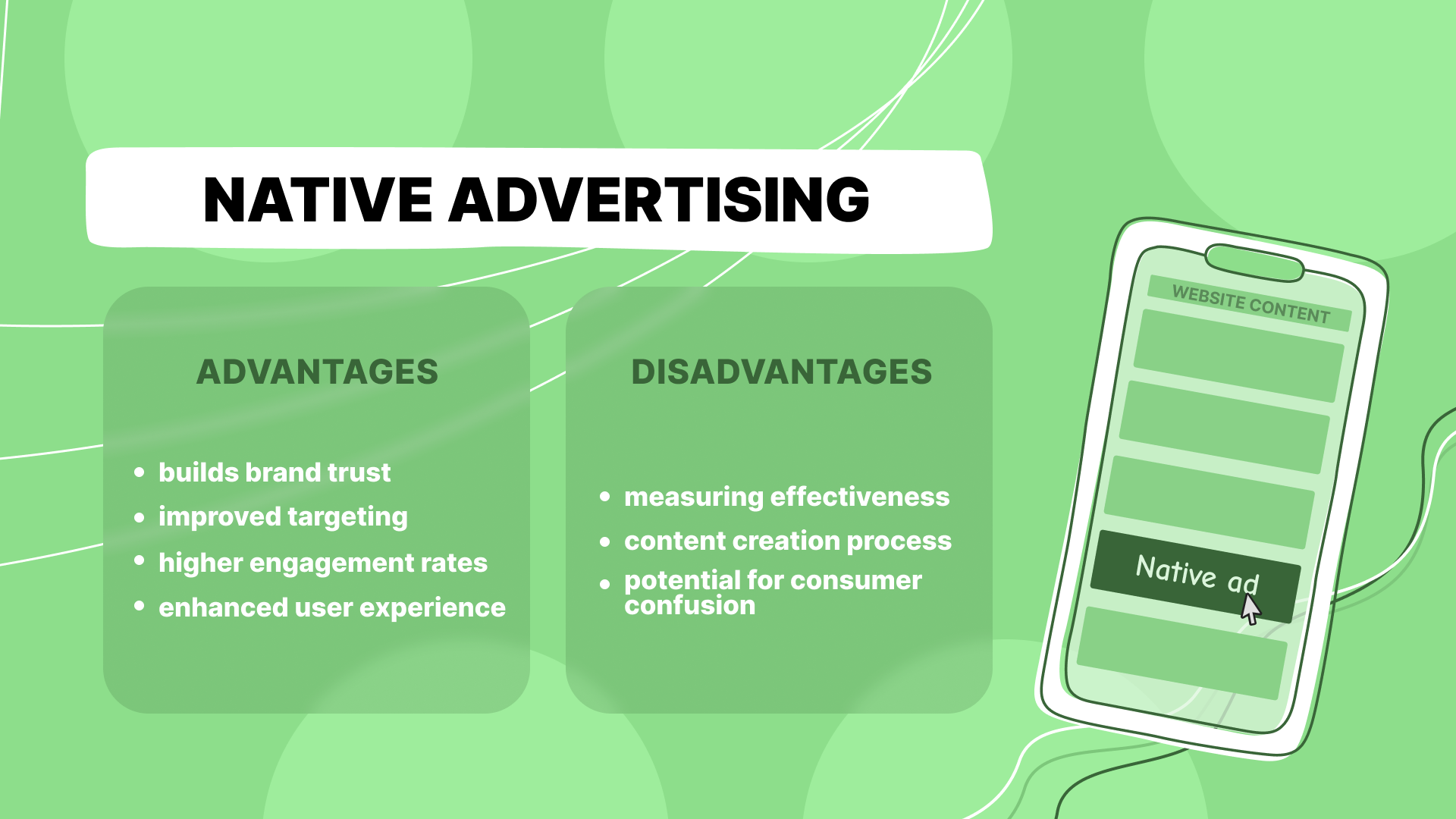
Native ads are designed to blend seamlessly with the content that surrounds them, providing a less intrusive advertising experience. These ads mimic the look, feel, and function of the media format in which they appear, whether it's an online article, social media feed, or video platform. The subtlety of native advertising lies in its ability to integrate commercial messages into a user's content experience without sticking out as overt advertising.
- How native ads function
Native advertising works by matching the visual design and content format of the website or platform on which it's displayed, ensuring it aligns with the natural user experience. Advertisers create content that is relevant and adds value, thereby engaging users without disrupting their online journey. This can range from sponsored content articles that resemble editorial pieces to promoted listings within search results or social feeds. - The target audience for native ads
Native ads are particularly effective for direct advertisers looking to build brand awareness and engagement in a subtle yet impactful way. This approach is favored by brands aiming for a soft-sell strategy rather than a direct response, including those in industries like fashion, lifestyle, and technology. It's also a preferred choice for content marketers and publishers seeking to offer valuable content while monetizing their platforms.
Advantages of native ads
- Enhanced user experience: Integrates smoothly with user content, reducing ad fatigue.
- Higher engagement rates: More likely to be read and shared, resembling the platform's natural content.
- Builds brand trust: Less intrusive ads contribute to a positive brand perception.
- Improved targeting: Often used in conjunction with content marketing strategies for more precise audience targeting.
Disadvantages of native ads
- Content creation costs: Requires higher investment in quality content creation.
- Potential for consumer confusion: If not clearly marked as sponsored, it can blur the line between content and advertising.
- Measuring effectiveness: Tracking ROI can be more complex due to the subtle nature of engagement metrics.
Dynamic content advertising
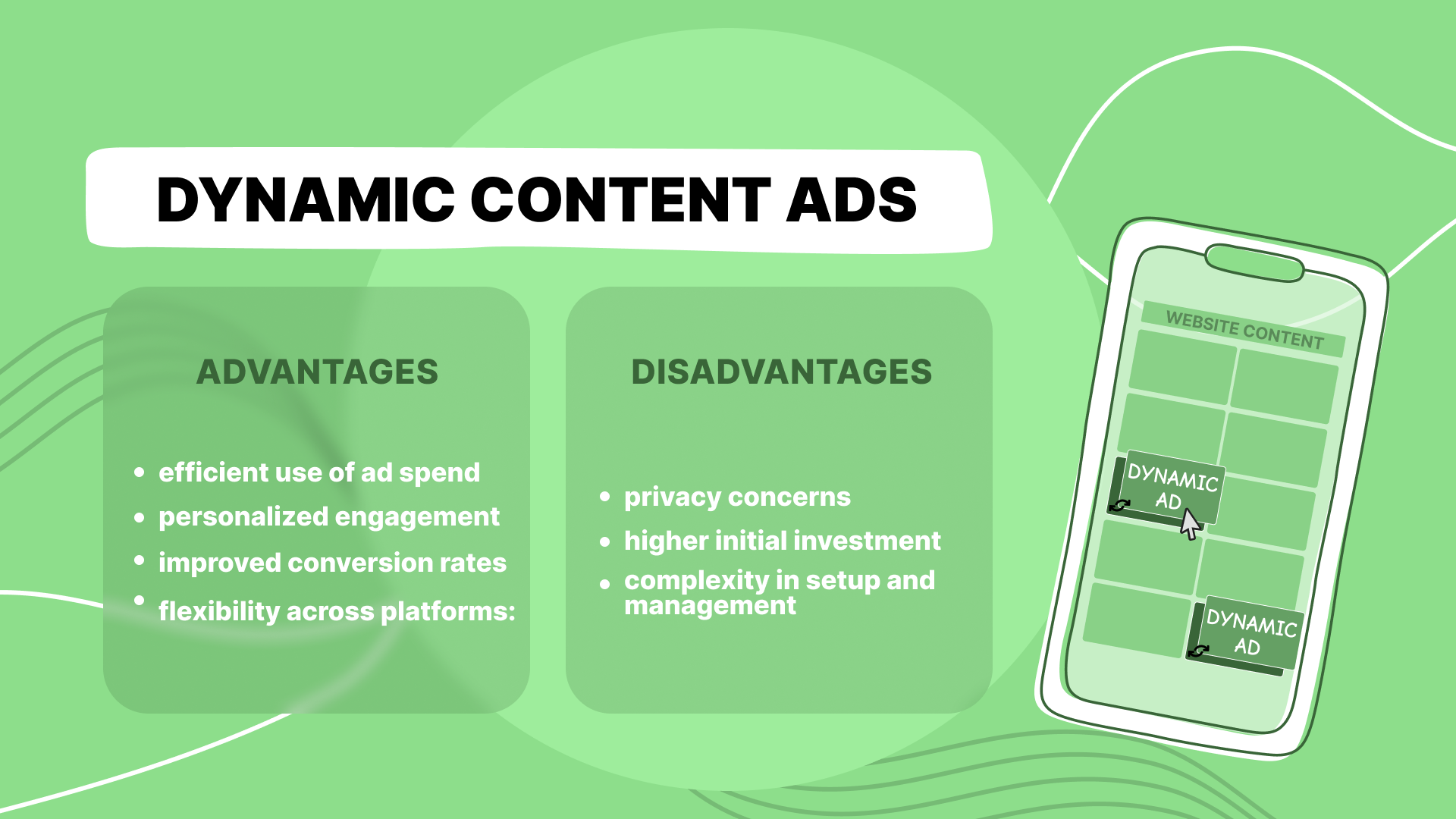
Dynamic content ads stand at the forefront of personalized advertising, offering a tailored approach that adjusts ad content in real time based on the viewer's behaviours, preferences, and past interactions. Unlike traditional static ads or even predefined VAST (Video Ad Serving Template) ads, dynamic content ads can change elements such as text, images, and calls-to-action to fit the specific context of each viewer, making every ad impression uniquely relevant.
- How dynamic content ads work
This advertising technology utilizes sophisticated algorithms and data analytics to assess a variety of factors, including user demographics, browsing history, and purchase behaviour. Based on this data, the ad dynamically alters its content to match the viewer's profile and interests. For video ads, this means beyond just serving a video; it's about customizing the message or even the storyline of the video content to the individual watching it. - Ideal for direct advertisers
Dynamic content advertising is especially beneficial for direct advertisers seeking to increase conversion rates through highly personalized advertising campaigns. It's a game-changer for sectors like e-commerce, travel, and real estate, where the ability to present tailored offers can significantly impact decision-making and enhance the customer journey.
Advantages of dynamic content ads
- Personalized engagement: A highly personalized ad experience increases relevance and connection.
- Improved conversion rates: Tailored messages mean higher engagement and conversion, as ads resonate more deeply with individual preferences.
- Efficient use of ad spend: By targeting more effectively, advertisers can reduce wasted impressions and increase ROI.
- Flexibility across platforms: Can be used across various digital platforms, including social media, websites, and email marketing.
Disadvantages of dynamic content ads
- Complexity in setup and management: Requires sophisticated data integration and analytics to personalize content effectively.
- Higher initial investment: The technology and creative variations needed for dynamic content can increase initial costs.
- Privacy concerns: Collecting and using personal data to tailor ads can raise consumer privacy issues, necessitating careful compliance with data protection laws.
Final thoughts
Innovations like immersive interstitial ads and precisely tailored dynamic content are redefining how we connect with audiences. The key to beating the odds? Keeping your finger on the pulse of these trends and embracing the new. Experimenting with emerging ad formats can elevate your campaigns and engage your audience in unexpected ways. So, as we explore the future of advertising, let's stay curious, creative, and ready to embrace the next wave of digital breakthroughs. The journey to impactful, memorable marketing starts with a willingness to innovate.
FAQs: Online display ads in 2024
What are the top online display ad formats to consider in 2024?
The leading ad formats for 2024 include immersive interstitial ads, engaging native ads, personalized dynamic content ads, and direct-push ads. Each offers unique ways to capture audience attention and drive engagement.
How do dynamic content ads work, and why are they important?
Dynamic content ads automatically adjust their content based on the viewer's behavior, preferences, and past interactions, offering a highly personalized advertising experience. They're important because they significantly increase ad relevance, which can lead to higher engagement and conversion rates.
Are native ads still effective in 2024?
Yes, native ads remain highly effective in 2024. Their ability to blend seamlessly with the surrounding content makes them less intrusive and more engaging to the audience, leading to better performance metrics compared to more traditional ad formats.
What challenges do advertisers face with interstitial ads?
While interstitial ads are highly visible, they can also be perceived as intrusive if not timed well or if they disrupt the user experience. Advertisers must balance the need for attention with the user's desire for a seamless online experience.
Can small businesses benefit from using push ads?
Absolutely. Push ads can be a cost-effective way for small businesses to engage with their audience directly, especially for time-sensitive offers or reminders. The key is to use them sparingly and ensure the content is highly relevant and valuable to the audience.
What role does AI play in online display advertising?
AI plays a crucial role in optimizing ad targeting, personalization, and performance analysis. It enables advertisers to create more relevant and effective campaigns by analyzing vast amounts of data to predict user behavior and preferences.
